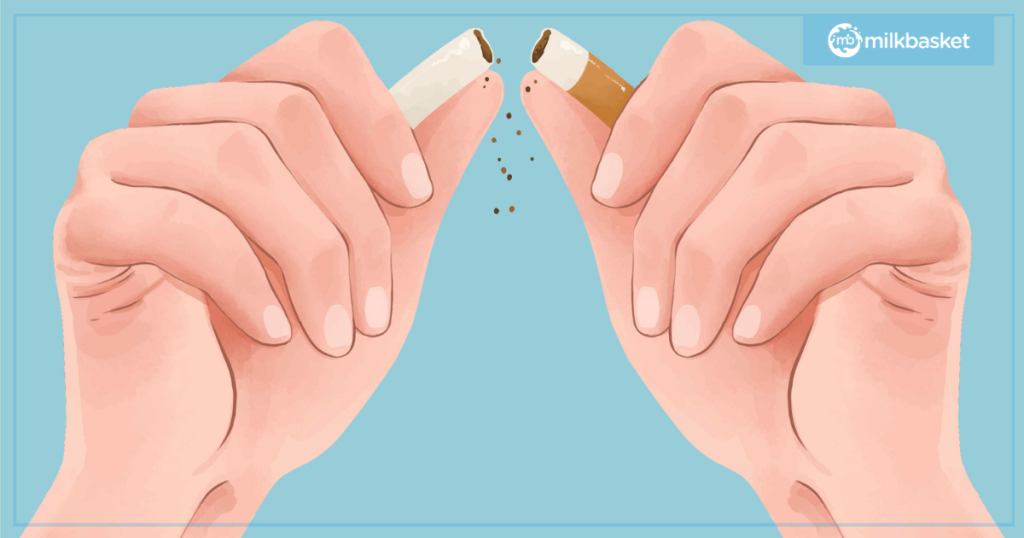4 Effective Ways To Keep Your Lungs Healthy After Quitting Smoking
It’s National No Smoking Day today, which is an annual event in the United Kingdom that takes place on the second Wednesday in March. This day is dedicated to raising awareness about the dangers of smoking and helping smokers to quit. The campaign is organized by the British Heart Foundation, and it has been running since 1984.
The theme for National No Smoking Day changes every year, but the message is always the same: quit smoking and improve your health. The campaign provides information, support, and resources to help people quit smoking, including free quitting packs, online support, and a helpline.
Smoking has been a part of Indian culture for centuries as well. Tobacco was first introduced to India by the Portuguese in the 16th century, and since then, smoking has become an integral part of Indian social and cultural practices. However, smoking is also a major public health concern in India, and it is estimated that around 120 million people in India smoke.
What Does Smoking Do To Our Lungs?

Smoking weakens the lungs by causing damage to the delicate tissues and structures in the respiratory system. When smoke from tobacco is inhaled, it releases a range of harmful chemicals that can have various harmful effects on the lungs. Here are some of the ways smoking can weaken the lungs:
- Inflammation – Smoking can cause inflammation in the lungs, which can damage the lung tissue and make it harder for the lungs to function properly. This inflammation can cause chronic bronchitis, a condition that makes the airways inflamed and narrow, causing coughing and shortness of breath.
- Reduced Lung Function – Smoking can reduce lung function by causing damage to the air sacs in the lungs. The air sacs, also known as alveoli, are responsible for exchanging oxygen and carbon dioxide in the lungs. Smoking can cause these air sacs to lose their elasticity, making it harder for them to expand and contract during breathing.
- Increased Mucus Production – Smoking can increase the production of mucus in the lungs, which can make it difficult to breathe. The excess mucus can clog the airways and cause coughing and wheezing.
- Decreased Immune Function – Smoking can weaken the immune system, making it harder for the body to fight off infections in the lungs. This can lead to a range of respiratory infections, including pneumonia.
- Damage to Lung Tissue – Smoking can damage the delicate tissues in the lungs, causing scarring and reducing the overall function of the lungs. Over time, this can lead to the development of chronic lung diseases, such as emphysema and chronic bronchitis.
Quitting Smoking Can Be Challenging

One of the main reasons why quitting smoking is so difficult is because nicotine is highly addictive. When you smoke, nicotine stimulates the release of dopamine in your brain, which is a chemical that makes you feel good. This creates a psychological addiction to smoking, as well as a physical addiction.
However, quitting smoking is not impossible, and the benefits of quitting are numerous. Within 20 minutes of quitting smoking, your blood pressure and heart rate return to normal. Within 48 hours, your sense of smell and taste improve, and your risk of heart attack starts to decrease. Within a year, your risk of heart disease is halved, and within ten years, your risk of lung cancer is also halved.
4 Ways To Recover Your Lungs
Now that we know that the lungs start recovering the moment you say ‘NO’ to smoking, that is an encouraging ray of light to start inculcating these 5 easy ways or habits to recover your lungs post smoking:
Steam Therapy

Steam therapy, also known as steam inhalation, is a natural remedy that involves inhaling warm, moist air to help open up the airways and promote healing in the lungs. This therapy can be particularly beneficial for people who have recently quit smoking, as it can help to reduce inflammation, clear out mucus, and improve lung function. Here’s how steam therapy works and how to do it effectively:
How Steam Therapy Works
Steam therapy works by helping to loosen mucus and phlegm in the lungs, making it easier to cough up and clear out. The warm, moist air can also help to reduce inflammation in the airways, which can help to improve breathing and reduce coughing.
How to Do Steam Therapy
- Boil a pot of water on the stove or use a steam machine. You can also add herbs, such as eucalyptus or peppermint, for added benefits.
- Once the water has boiled, remove it from the heat and let it cool for a minute or two.
- Position your face over the pot or steam machine and cover your head with a towel to trap the steam.
- Breathe in deeply through your nose and mouth, inhaling the steam for 5-10 minutes.
- Be sure to keep your eyes closed during the treatment to avoid irritation.
- Repeat the process two or three times a day, as needed.
Postural Drainage
Postural drainage is a technique that involves positioning the body in specific ways to help drain mucus and secretions from the lungs. This technique can be particularly helpful for people recovering from smoking, as it can help to clear out the lungs and improve breathing.
How Postural Drainage Works
Postural drainage works by using gravity to help move mucus and secretions from the lungs into the central airways, where they can be coughed up and cleared out. This technique involves positioning the body in various ways to target specific areas of the lungs and promote drainage.
How to Do Postural Drainage
- Consult with a healthcare provider to determine which postures are appropriate for you based on your lung condition.
- Position yourself in the first posture, which typically involves lying on your stomach with your head and upper body tilted downward.
- Remain in this position for 10-15 minutes, taking slow, deep breaths.
- Move to the next posture, which may involve lying on your side or back with your head and chest elevated.
- Repeat this process for each of the recommended postures.
- Be sure to cough and deep breathe after each posture to help clear out the mucus and secretions.
Tips for Effective Postural Drainage
- Always consult with a healthcare provider before starting postural drainage to ensure it is safe and appropriate for you.
- Use caution when changing positions to avoid dizziness or falls.
- Combine postural drainage with other natural remedies, such as steam therapy and breathing exercises, to promote healing in the lungs.
- Stay hydrated by drinking plenty of water before and after the postural drainage.
- Be consistent with your postural drainage routine, performing it at least twice a day as recommended by your healthcare provider.
Daily Exercise

Regular exercise is an essential part of a healthy lifestyle, and it can also be particularly helpful for people recovering from smoking. Exercise can help to improve lung function, reduce inflammation, and boost overall health and wellbeing. Here’s how exercising daily can help you recover from smoking:
- Improves lung function: Smoking can damage the lungs and reduce lung function. Regular exercise can help to improve lung capacity, increase oxygen intake, and strengthen the muscles used for breathing.
- Reduces inflammation: Smoking can cause inflammation in the airways and throughout the body, which can contribute to a range of health problems. Exercise has been shown to reduce inflammation and improve immune function, which can help to reduce the risk of chronic diseases.
- Boosts overall health: Smoking can increase the risk of a range of health problems, including heart disease, stroke, and cancer.
Diaphragmatic Breathing

Diaphragmatic breathing, also known as belly breathing, is a technique that can help to strengthen the diaphragm muscle and improve lung function. It is a simple and effective way to support lung recovery after smoking.
Here’s how to do it:
- Find a comfortable, quiet place to sit or lie down.
- Place one hand on your chest and the other hand on your belly.
- Take a slow, deep breath in through your nose, allowing your belly to expand and your diaphragm to move downward. You should feel your hand on your belly rise as you inhale.
- Hold your breath for a few seconds.
- Slowly exhale through your mouth, allowing your belly to deflate and your diaphragm to move upward. You should feel your hand on your belly lower as you exhale.
- Repeat this process for several minutes, focusing on slow, deep breaths and relaxing your body.
Diaphragmatic breathing can help to improve lung function by strengthening the diaphragm muscle, which is responsible for helping you breathe. It can also help to reduce stress and anxiety, which can be beneficial for overall health and wellbeing.
Quitting smoking is no joke, but now that you have decided to quit, this blog shall help you to speed up the recovery of your lungs and live a healthy life to cherish each moment with a smile!
Cheers!
Categories
Popular Posts
-

4 Eco-Friendly Decorations for Ganesh Chaturthi
Spread the loveLooking for sustainable eco Ganpati decoration ideas as Ganesh Chaturthi approaches on August 26, 2025? You’re not alone in wanting to celebrate Lord Ganesha while protecting our environment. This festival season, you can create beautiful decorations that honor tradition without harming the environment. Milkbasket understands your need for convenient online grocery delivery during […]
19 Aug 2025 read More... -

Milkbasket – A Revolution In The Online Grocery Delivery Services In India
Spread the loveThere’s no denying the fact that the pandemic has drastically changed the way people spend their time online, buying everything through various online retail platforms with the convenience of home deliveries in India. Milkbasket, with it’s features has proven to be a revolution in the online grocery delivery services in India. While stepping […]
08 Jul 2022 read More... -

Milkbasket’s Latest DVC Campaign Is Out, And It’s Quirky And Relatable As Heck!
Spread the loveThe year 2021 was all about patience, resilience, and the grind it takes to get back up from a worldwide slump that the COVID-19 pandemic had hit us with. It made us all revisit our roots, recalibrate our priorities, and strengthen our foundations. With the better part of 2022 gone into slowly spreading […]
28 Sep 2022 read More... -

Nabhi Chikitsa or Belly Button Therapy: The Simple Health Secret You NEED To Know!
Spread the loveOur Navel or Belly Button (scientific name Umbilicus) is believed to be the centre of our life force. Most of us take it as just another part of our body not knowing its deep, thrilling world. In ancient Hindu healing practices, the Navel is considered to be the most important point of the […]
08 Sep 2022 read More...





